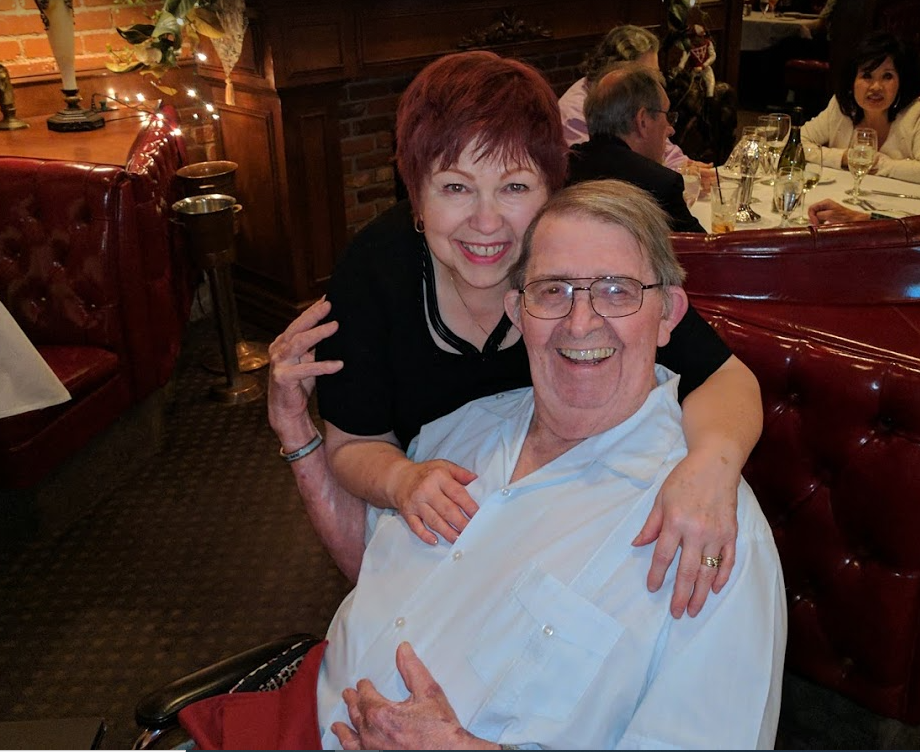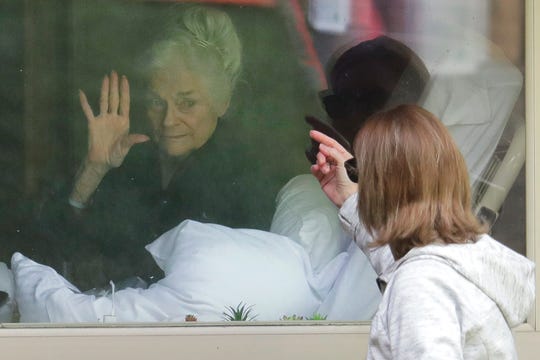Essential caregivers were locked out of nursing homes during COVID-19. Advocates from New York to California don’t want it to happen again.
In many long-term care facilities, there are the regular visitors — family members who arrive daily to talk, clip nails, ensure meals don’t sit untouched, comb hair and, in quiet moments, hold hands.
Last summer, after several months of being locked out of facilities due to the coronavirus pandemic, the regulars grew increasingly concerned that their loved ones were suffering from prolonged isolation. Through Facebook and Twitter, hundreds, then thousands of these caregivers joined efforts.
From New York to Illinois to California, advocates have rallied state and federal lawmakers to enact laws that will permit such essential caregivers to enter long-term care settings, even during a public health emergency. They’ve organized email blasts, rallies, even a travelling yard sign campaign. Their efforts prompted New York to pass a bill this spring. Arkansas, too. About a dozen other states have had essential caregiving bills at least introduced.
“I think some of our elderly simply gave up. They were in for days, months, without anybody,” said state Rep. Julie Mayberry, a Republican legislator who sponsored the No Patient Left Alone Act that Arkansas passed in March. “I believe more people would be alive today if they had a loved one in there helping them.”
The bills in state legislatures go by various names but have similar bones. Under them, residents at long-term care settings would designate at least one person as an essential caregiver who could not be barred from visiting even during a pandemic. In turn, those designated caregivers would have to abide by the same safety protocols staff adhere to, such as symptom screening and masking.
Roads, bridges … and caregivers? Why Biden is pushing a ‘radical shift’ to redefine infrastructure
For advocates such as Marcella Goheen, whose husband lives in a Manhattan nursing home, the laws offer a layer of security. Before them, there were no guarantees, she noted. “Now we’re protected to a certain extent.”
In California, where about 85,000 people live in 1,200 skilled nursing facilities and roughly 195,000 are in other long-term care settings, there’s been no traction for essential caregiver bills, though lawmakers are considering bills that would improve quality of care in nursing homes or require better government oversight.
Pat McGinnis, executive director of the California Advocates for Nursing Home Reform, believes legislators are being overly cautious in steering clear of caregiver mandates. “They’re more concerned about the spread [of disease] and that they’ll be held responsible if they allow designated caregivers in,” she said. “But I think it’s a lifesaving amenity for people in nursing homes.”

Melody Taylor Stark and her husband, Bill, smile for a photo on their wedding anniversary in 2019. (Photo: Melody Taylor Stark/Courtesy to USA TODAY)
The virus spread quickly through communal settings, prompting the lockdowns that isolated residents. About 132,300 long-term care residents in the United States have died of COVID-19, according to the Centers for Medicare & Medicaid Services — including 13,000 in California facilities, according to data compiled by the Los Angeles Times.
In most states considering essential caregiver legislation, sponsors and vocal supporters have been Republicans. McGinnis says the concept aligns with the party’s push to loosen COVID-19 restrictions. California advocates say they’ve had no luck trying to interest members of the state Assembly’s Aging and Long-Term Care Committee — neither Republican nor Democrat. The chairperson of that committee, Adrin Nazarian, did not return a call or email for comment on this story.
A spokesperson for the California Association for Health Facilities agreed that families are crucial to the well-being of residents, but said in a statement that opening doors to caregivers during a public health emergency could raise “a number of issues, involving caregiver training, infection prevention, patient and visitor safety and liability, among other things.”
Long-term care patients struggle with weight loss, personal hygiene
That rationale worries people like Melody Taylor Stark, a Southern California resident who couldn’t visit her 84-year-old husband’s nursing home for eight months.
“Now that facilities have a precedent for lockdowns, there needs to be a precedent for keeping connections,” she said.
No one questions the value of maintaining those connections. During the pandemic, the families of people in long-term care recounted stories of mothers and fathers, husbands and wives, who slipped into despair or became despondent during the prolonged period of detachment from the people they love. Some families also documented a lack of hygiene or other physical changes in their loved ones that would have been noticed sooner by daily visitors.
During FaceTime calls, Stark could see that her husband, Bill, a retired dentist, looked unkempt — his fingernails long, his hair matted and scratched skin lesions on his arms. On one call, she asked to see his hands. There was dried blood beneath the nails from all the scratching. Had she been there, she would have addressed those issues herself.
“I’d call him and he’d be crying and say, ‘This is no way to live.'”
Doctors also have remarked on the changes. Many long-term care residents lost weight during the pandemic, said Dr. Louise Aronson, a geriatrician and professor of medicine at University of California San Francisco.
“There were people who routinely brought them the food of their culture, which that wasn’t happening,” she said. “So we’re having weight loss at a time in life where we know having a little extra weight correlates with better health outcomes.”
And something even more disturbing may have been happening. According to Aronson, evidence has emerged of increased use of psychotic drugs and sedation of nursing home residents during the pandemic.

Judie Shape, left, waves to her daughter, Lori Spencer, through a window on March 11, 2020, after the Life Care Center in Kirkland, Wash., near Seattle, had stopped in-person visits. (Photo: Ted S. Warren, AP)
While there is reason for families to be concerned, imposing essential caregiver mandates on nursing homes may do more harm than good, some policy makers and industry officials believe.
Essential caregiving bills have failed to move forward in Georgia, Colorado and other states. State Sen. Jill Tracy, a Republican from Illinois, lamented her bill was “dead in the water,” after failing to get Democratic support.
‘I’m not OK but I’m doing the best I can’: Caregivers face impossible challenges during COVID
During an April House committee hearing in Colorado, both the Colorado Nurses Association and the Colorado Hospital Association spoke against the bill that would’ve permitted essential caregivers in hospitals and long-term-care homes.
“There’s no joy, no pride in restricting visitation,” said Joshua Ewing, vice president of legislative affairs for the Colorado Hospital Association. “This is not an action that is taken by hospitals, by medical professionals, to make their lives easier. It is about saving lives.”
Will long-term care lockdowns become the norm in future pandemics?
Where essential caregiver laws have passed, the catalyst has been COVID-19. But no one knows what disease may lie ahead or how contagious it might be, said Dr. John Swartzberg, a University of California, Berkeley, infectious disease specialist.
“I’m just concerned in a future pandemic when we don’t understand what’s going on very well, saying, ‘Well, that’s too bad, we have a law that says one visitor can come in,’” he said.
Another drawback to the bills is that state laws only wield so much power. Should the Centers for Medicare & Medicaid Services dictate closures of nursing homes due to a public health emergency, as it did last March, states would have to comply or risk losing Medicaid and Medicare funds.
A nursing home in May 2020 in Windsor, Connecticut. (Photo: Chris Ehrmann/AP)
“If the federal government says it’s not allowed, it’s not allowed,” Mayberry said.
In March, U.S. Rep. Claudia Tenney, a Republican from upstate New York, introduced a House bill that would overhaul sections of the Social Security Act and require nursing facilities and other long-term care settings to permit essential caregivers during a public health crisis. But no detailed text of the bill had been filed by May and no committee hearing had been scheduled.
In the absence of federal or state legislation, advocates such as Maitely Weismann, a cofounder of the Essential Caregivers Coalition who lives in Los Angeles, fears that lockdowns may become the norm.
“This has normalized to the point that we’re concerned that the flu season will make the lockdowns happen again,” she said.
She and others also want guarantees that an ombudsman will be allowed into nursing homes during public health emergencies to look out for the majority of residents who don’t have regular visitors.
That feeling you can’t name? It’s called emotional exhaustion.
Nicole Howell, executive director of ombudsman services for three California counties, said that for four months last year her staff was unable to perform routine, in-person visits to check for signs of neglect and the overall health of residents.
Federal and state guidelines now allow indoor visits at nursing homes, with masks and temperature checks, though some facilities remain resistant and are sticking with their own stricter protocol.
Melody Taylor Stark, the California woman whose husband was in a nursing home, said state laws would at least create uniform rules and provide for penalties if facilities didn’t follow them.
She remembers the day she last hugged Bill — March 13, 2020. After that, they relied on technology. At first, they managed the distance with coordinated viewings of Dodgers games or “Stranger Things” on Netflix. But, in May, Bill, a normally upbeat guy, started crying on the phone.
“I’d call him and he’d be crying and say, ‘This is no way to live,’” she recalled.
The staff arranged for the Starks to toast their 20th wedding anniversary from a distance. Standing outside her husband’s room, they blew each other kisses. Melody Taylor Stark toasted with a glass of champagne; Bill raised a Scotch.
The next time she saw him in person was mid-November. His health was rapidly declining. Stark believes isolation may have been partly to blame. During that last visit, she had to stand 6 feet away. And was only allowed 15 minutes.
Even with a mask, face shield and gloves, Stark said she wasn’t allowed to hug him. Bill died due to complications from congestive heart failure and pneumonia a few days before Thanksgiving.
Stark can’t help but reflect on the precious time that was lost, the moments she wasn’t by his side, offering comfort. Safety, she noted, has come at a cost for nursing home residents.
“We’re protecting them to death,” she said.
Anne Marshall-Chalmers writes for the Investigative Reporting Program at the University of California, Berkeley, Graduate School of Journalism.
Source: Read Full Article

